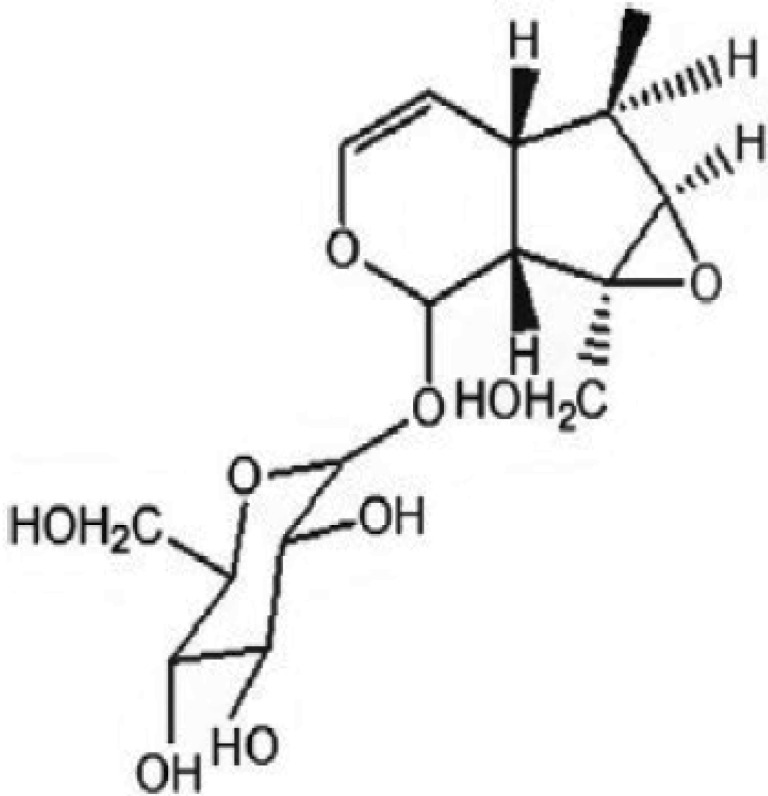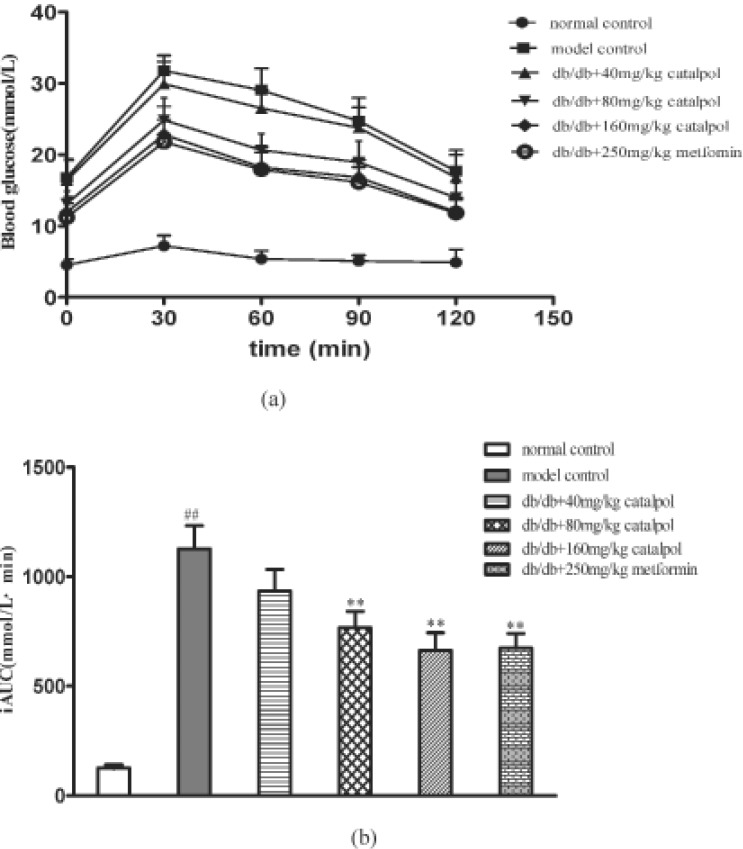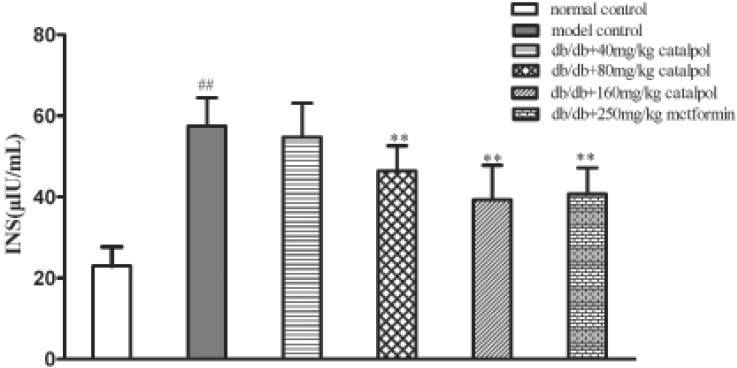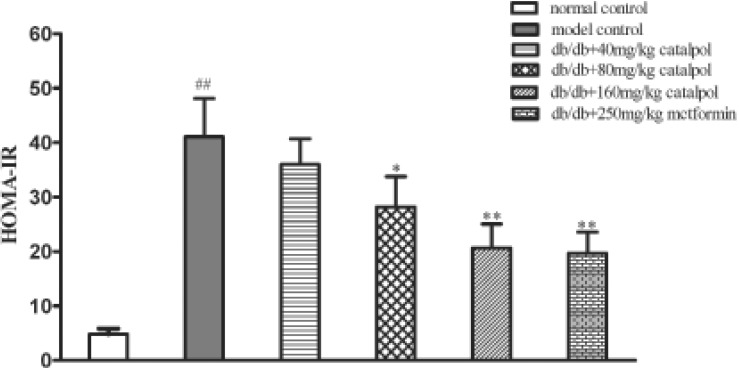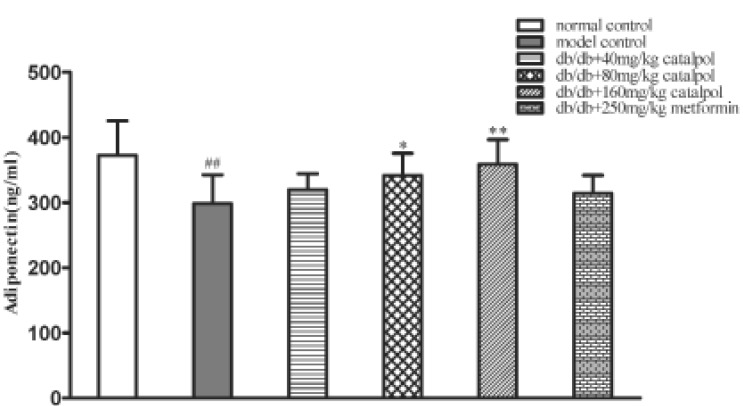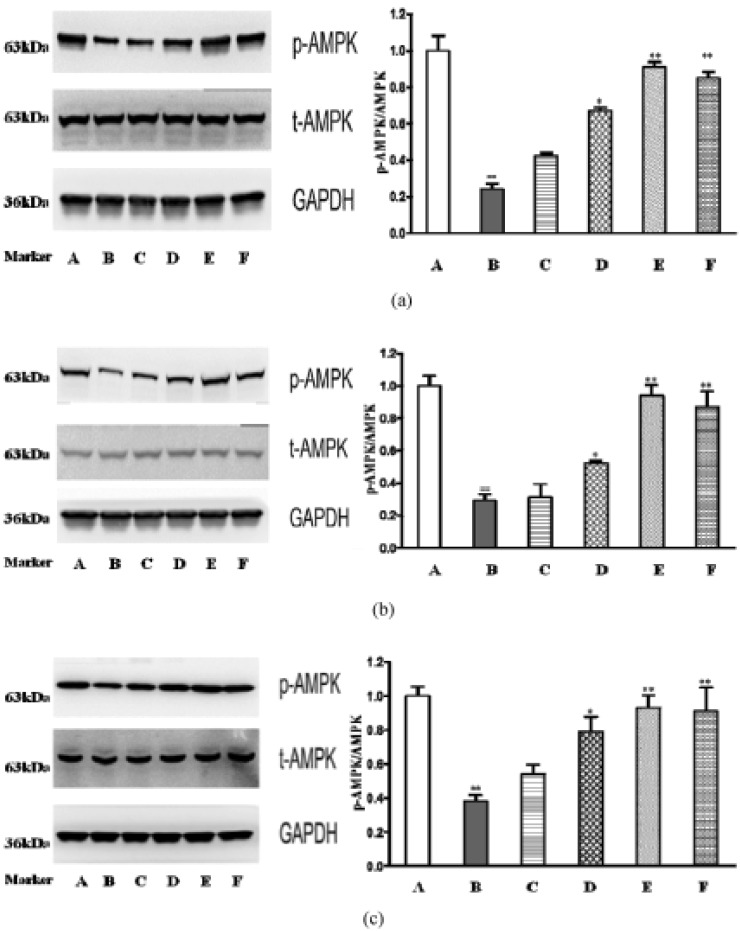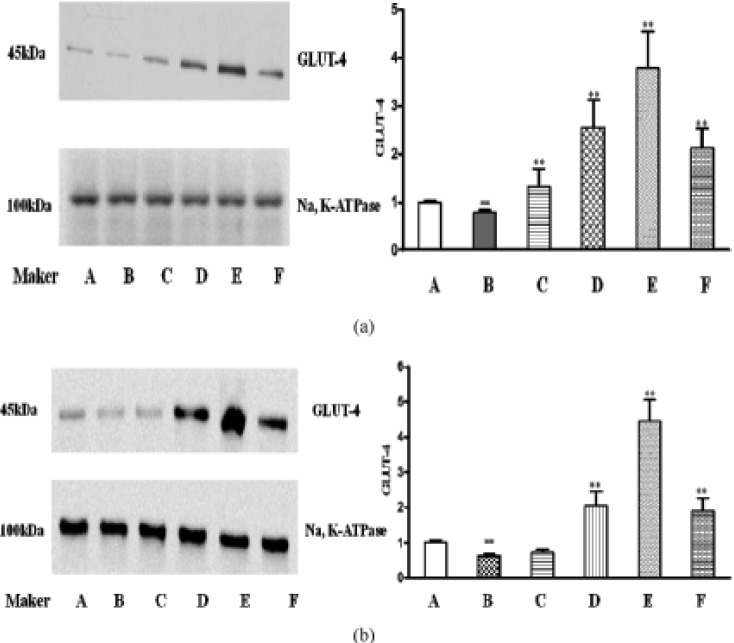Korean J Physiol Pharmacol.
2016 Mar;20(2):153-160. 10.4196/kjpp.2016.20.2.153.
Anti-diabetic activities of catalpol in db/db mice
- Affiliations
-
- 1Department of Geriatric, Lianyungang Second People's Hospital of Jiangsu Province East Hospital, Jiangsu Province, Lianyungang 222002, PR China. bao_qinwen@163.com
- 2Department of Clinical, Lianyungang Second People's Hospital of Jiangsu Province East Hospital, Jiangsu Province, Lianyungang 222002, PR China.
- KMID: 2388671
- DOI: http://doi.org/10.4196/kjpp.2016.20.2.153
Abstract
- The objective was to investigate the hypoglycemic action of catalpol in spontaneous diabetes db/db mice. 40 db/db mice were randomly divided into fi ve groups: model control gourp; db/db plus catalpol 40, 80, 120 mg/kg body wt. groups and db/db plus metformin 250 mg/kg group. Age-matched db/m mice were selected as normal control group. The mice were administered with corresponding drugs or solvent by gavage for 4 weeks. The oral glucose tolerance test was carried out at the end of 3rd week. After 4 weeks of treatment, the concentrations of fasting blood glucose (FBG), glycated serum protein (GSP), insulin (INS), triglyceride (TG), total cholesterol (TC) and adiponection (APN) in serum were detected. The protein expressions of phosphorylation-AMPKalpha1/2 in liver, phosphorylation-AMPKalpha1/2 and glucose transporter-4 (GLUT-4) in skeletal muscle and adipose tissues were detected by western blot. Real time RT-PCR was used to detect the mRNA expressions of acetyl-CoA carboxylase (ACC) and Hydroxymethyl glutaric acid acyl CoA reductase (HMGCR) in liver. Our results showed that catalpol could significantly improve the insulin resistance, decrease the serum concentrations of INS, GSP, TG, and TC. The concentrations of APN in serum, the protein expression of phosphorylation-AMPKalpha1/2 in liver, phosphorylation-AMPKalpha1/2 and GLUT-4 in peripheral tissue were increased. Catalpol could also down regulate the mRNA expressions of ACC and HMGCR in liver. In conclusion, catalpol ameliorates diabetes in db/db mice. It has benefi t eff ects against lipid/glucose metabolism disorder and insulin resistance. The mechanism may be related to up-regulating the expression of phosphorylation-AMPKalpha1/2.
Keyword
MeSH Terms
-
Acetyl-CoA Carboxylase
Acyl Coenzyme A
AMP-Activated Protein Kinases
Animals
Blood Glucose
Blotting, Western
Cholesterol
Fasting
Glucose
Glucose Tolerance Test
Insulin
Insulin Resistance
Liver
Metabolism
Metformin
Mice*
Muscle, Skeletal
Oxidoreductases
RNA, Messenger
Triglycerides
AMP-Activated Protein Kinases
Acetyl-CoA Carboxylase
Acyl Coenzyme A
Blood Glucose
Cholesterol
Glucose
Insulin
Metformin
Oxidoreductases
RNA, Messenger
Figure
Reference
-
1. Jiménez-Flores LM, López-Briones S, Macías-Cervantes MH, Ramírez-Emiliano J, Pérez-Vázquez V. A PPARγ, NF-κB and AMPK-dependent mechanism may be involved in the beneficial effects of curcumin in the diabetic db/db mice liver. Molecules. 2014; 19:8289–8302. PMID: 24945581.
Article2. Chiang CK, Ho TI, Peng YS, Hsu SP, Pai MF, Yang SY, Hung KY, Wu KD. Rosiglitazone in diabetes control in hemodialysis patients with and without viral hepatitis infection: effectiveness and side effects. Diabetes Care. 2007; 30:3–7. PMID: 17192324.3. Wang Z, Wang J, Chan P. Treating type 2 diabetes mellitus with traditional chinese and Indian medicinal herbs. Evid Based Complement Alternat Med. 2013; 2013:343594. PMID: 23737828.
Article4. Pungitore CR, Ayub MJ, Borkowski EJ, Tonn CE, Ciuffo GM. Inhibition of Taq DNA polymerase by catalpol. Cell Mol Biol (Noisy-le-grand). 2004; 50:767–772. PMID: 15641169.5. Wei M, Lu Y, Liu D, Ru W. Ovarian failure-resistant effects of catalpol in aged female rats. Biol Pharm Bull. 2014; 37:1444–1449. PMID: 25177027.
Article6. Jiang B, Shen RF, Bi J, Tian XS, Hinchliffe T, Xia Y. Catalpol: a potential therapeutic for neurodegenerative diseases. Curr Med Chem. 2015; 22:1278–1291. PMID: 25620103.
Article7. Li X, Xu Z, Jiang Z, Sun L, Ji J, Miao J, Zhang X, Li X, Huang S, Wang T, Zhang L. Hypoglycemic effect of catalpol on high-fat diet/streptozotocin-induced diabetic mice by increasing skeletal muscle mitochondrial biogenesis. Acta Biochim Biophys Sin (Shanghai). 2014; 46:738–748. PMID: 25178463.
Article8. Shieh JP, Cheng KC, Chung HH, Kerh YF, Yeh CH, Cheng JT. Plasma glucose lowering mechanisms of catalpol, an active principle from roots of Rehmannia glutinosa, in streptozotocin-induced diabetic rats. J Agric Food Chem. 2011; 59:3747–3753. PMID: 21391677.
Article9. Bogdanov P, Corraliza L, Villena JA, Carvalho AR, Garcia-Arumí J, Ramos D, Ruberte J, Simó R, Hernández C. The db/db mouse: a useful model for the study of diabetic retinal neurodegeneration. PLoS One. 2014; 9:e97302. PMID: 24837086.
Article10. Zhang C, Gui L, Xu Y, Wu T, Liu D. Preventive effects of andrographolide on the development of diabetes in autoimmune diabetic NOD mice by inducing immune tolerance. Int Immunopharmacol. 2013; 16:451–456. PMID: 23707775.
Article11. Pentinat T, Ramon-Krauel M, Cebria J, Diaz R, Jimenez-Chillaron JC. Transgenerational inheritance of glucose intolerance in a mouse model of neonatal overnutrition. Endocrinology. 2010; 151:5617–5623. PMID: 20943806.
Article12. Pfaffl MW. A new mathematical model for relative quantification in real-time RT-PCR. Nucleic Acids Res. 2001; 29:e45. PMID: 11328886.
Article13. Zhang XD, Yan JW, Yan GR, Sun XY, Ji J, Li YM, Hu YH, Wang HY. Pharmacological inhibition of diacylglycerol acyltransferase 1 reduces body weight gain, hyperlipidemia, and hepatic steatosis in db/db mice. Acta Pharmacol Sin. 2010; 31:1470–1477. PMID: 21052084.
Article14. Sattar N, Gill JM. Type 2 diabetes as a disease of ectopic fat? BMC Med. 2014; 12:123. PMID: 25159817.
Article15. Wang G, Xu X, Yao X, Zhu Z, Yu L, Chen L, Chen J, Shen X. Latanoprost effectively ameliorates glucose and lipid disorders in db/db and ob/ob mice. Diabetologia. 2013; 56:2702–2712. PMID: 23989723.
Article16. Zhong X, Chung AC, Chen HY, Dong Y, Meng XM, Li R, Yang W, Hou FF, Lan HY. miR-21 is a key therapeutic target for renal injury in a mouse model of type 2 diabetes. Diabetologia. 2013; 56:663–674. PMID: 23292313.
Article17. Kang SJ, Lee JE, Lee EK, Jung DH, Song CH, Park SJ, Choi SH, Han CH, Ku SK, Lee YJ. Fermentation with Aquilariae Lignum enhances the anti-diabetic activity of green tea in type II diabetic db/db mouse. Nutrients. 2014; 6:3536–3571. PMID: 25207824.
Article18. Dong Z, Chen CX. Effect of catalpol on diabetic nephropathy in rats. Phytomedicine. 2013; 20:1023–1029. PMID: 23746755.
Article19. Huang WJ, Niu HS, Lin MH, Cheng JT, Hsu FL. Antihyperglycemic effect of catalpol in streptozotocin-induced diabetic rats. J Nat Prod. 2010; 73:1170–1172. PMID: 20518543.
Article20. Szkudelski T. The mechanism of alloxan and streptozotocin action in B cells of the rat pancreas. Physiol Res. 2001; 50:537–546. PMID: 11829314.21. Farese RV, Lee MC, Sajan MP. Atypical PKC: a target for treating insulin-resistant disorders of obesity, the metabolic syndrome and type 2 diabetes mellitus. Expert Opin Ther Targets. 2014; 18:1163–1175. PMID: 25213731.
Article22. Kim S, Jung J, Kim H, Heo RW, Yi CO, Lee JE, Jeon BT, Kim WH, Hahm JR, Roh GS. Exendin-4 improves nonalcoholic fatty liver disease by regulating glucose transporter 4 expression in ob/ob mice. Korean J Physiol Pharmacol. 2014; 18:333–339. PMID: 25177166.
Article23. Coughlan KA, Valentine RJ, Ruderman NB, Saha AK. AMPK activation: a therapeutic target for type 2 diabetes? Diabetes Metab Syndr Obes. 2014; 7:241–253. PMID: 25018645.24. Kurth-Kraczek EJ, Hirshman MF, Goodyear LJ, Winder WW. 5' AMP-activated protein kinase activation causes GLUT4 translocation in skeletal muscle. Diabetes. 1999; 48:1667–1671. PMID: 10426389.
Article25. Yamaguchi S, Katahira H, Ozawa S, Nakamichi Y, Tanaka T, Shimoyama T, Takahashi K, Yoshimoto K, Imaizumi MO, Nagamatsu S, Ishida H. Activators of AMP-activated protein kinase enhance GLUT4 translocation and its glucose transport activity in 3T3-L1 adipocytes. Am J Physiol Endocrinol Metab. 2005; 289:E643–E649. PMID: 15928020.
Article26. Steinberg GR, Kemp BE. AMPK in Health and Disease. Physiol Rev. 2009; 89:1025–1078. PMID: 19584320.
Article27. Hu N, Yuan L, Li HJ, Huang C, Mao QM, Zhang YY, Lin M, Sun YQ, Zhong XY, Tang P, Lu X. Anti-diabetic activities of jiaotaiwan in db/db mice by augmentation of AMPK protein activity and upregulation of GLUT4 expression. Evid Based Complement Alternat Med. 2013; 2013:180721. PMID: 23818920.
Article28. Biden TJ, Boslem E, Chu KY, Sue N. Lipotoxic endoplasmic reticulum stress, β cell failure, and type 2 diabetes mellitus. Trends Endocrinol Metab. 2014; 25:389–398. PMID: 24656915.
Article29. Henin N, Vincent MF, Gruber HE, Van den Berghe G. Inhibition of fatty acid and cholesterol synthesis by stimulation of AMP-activated protein kinase. FASEB J. 1995; 9:541–546. PMID: 7737463.
Article30. Maeda K, Okubo K, Shimomura I, Funahashi T, Matsuzawa Y, Matsubara K. cDNA cloning and expression of a novel adipose specific collagen-like factor, apM1 (AdiPose Most abundant Gene transcript 1). Biochem Biophys Res Commun. 1996; 221:286–289. PMID: 8619847.31. Yamauchi T, Kamon J, Ito Y, Tsuchida A, Yokomizo T, Kita S, Sugiyama T, Miyagishi M, Hara K, Tsunoda M, Murakami K, Ohteki T, Uchida S, Takekawa S, Waki H, Tsuno NH, Shibata Y, Terauchi Y, Froguel P, Tobe K, Koyasu S, Taira K, Kitamura T, Shimizu T, Nagai R, Kadowaki T. Cloning of adiponectin receptors that mediate antidiabetic metabolic effects. Nature. 2003; 423:762–769. PMID: 12802337.
Article32. Coimbra S, Brandão Proença J, Santos-Silva A, Neuparth MJ. Adiponectin, leptin, and chemerin in elderly patients with type 2 diabetes mellitus: a close linkage with obesity and length of the disease. Biomed Res Int. 2014; 2014:701915. PMID: 25105135.
Article33. Yamauchi T, Kamon J, Minokoshi Y, Ito Y, Waki H, Uchida S, Yamashita S, Noda M, Kita S, Ueki K, Eto K, Akanuma Y, Froguel P, Foufelle F, Ferre P, Carling D, Kimura S, Nagai R, Kahn BB, Kadowaki T. Adiponectin stimulates glucose utilization and fatty-acid oxidation by activating AMP-activated protein kinase. Nat Med. 2002; 8:1288–1295. PMID: 12368907.
Article
- Full Text Links
- Actions
-
Cited
- CITED
-
- Close
- Share
- Similar articles
-
- Sargassum coreanum extract alleviates hyperglycemia and improves insulin resistance in db/db diabetic mice
- Daraesoon (shoot of hardy kiwi) mitigates hyperglycemia in db/db mice by alleviating insulin resistance and inflammation
- Effect of glucagon-like peptide 1 on salivary gland hypofunction in diabetic db/db mice
- Silk fibroin hydrolysate exerts an anti-diabetic effect by increasing pancreatic beta cell mass in C57BL/KsJ-db/db mice
- Morphologic Comparison of Peripheral Nerves in Adipocyte Tissue from db/db Diabetic versus Normal Mice

